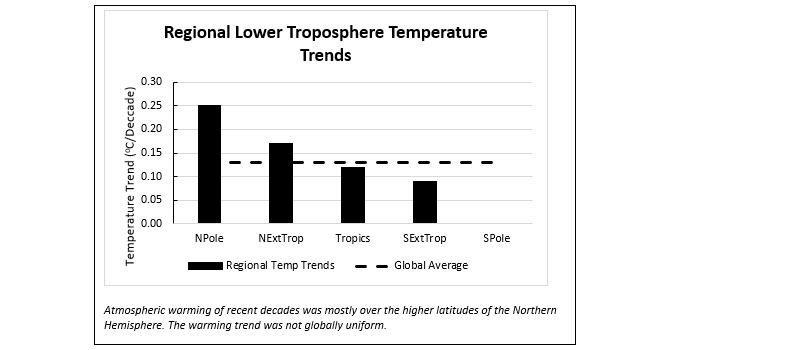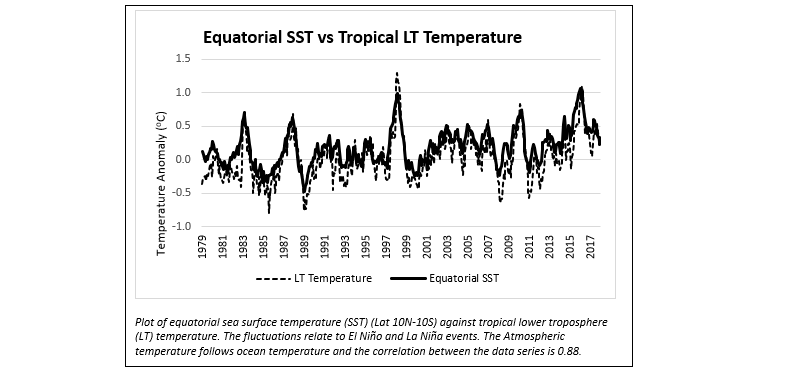William Kininmonth Paris Is No Longer Relevant
https://quadrant.org.au/opinion/doomed-planet/2018/08/paris-longer-relevant/
With The Lodge flushed there is a possibility of post-Turnbullian sanity, with the first priority being to re-evaluate Australia’s commitment to the Paris Agreement. As a nation, we are pauperising ourselves in a cause demonstrably false and easily discerned as such.
National energy policy is failing to satisfy what has been described as the trilemma of objectives: meeting national commitments for emissions reduction under the Paris Agreement; providing affordable energy; and ensuring continuity of supply.
There is potential flexibility for adopting different technologies to provide affordability and continuity of supply, but governments are tightly constrained by the need for national emissions reduction.
Australia is further constrained by policy shackles of its own making. Legislation is in place that rules out the most obvious technology readily satisfying the policy trilemma: nuclear generation. The reluctance to consider nuclear is baffling considering that seventy percent of France’s electricity generation is from nuclear and the global nuclear increase from 2016 to 2017 was a not inconsequential 65 terawatt hours. That is, nuclear provided more than 10 percent of the global increase in electricity generation, the equivalent of 10 new Hazelwoods.
Not surprising, the government’s favoured option of renewable energy, in the forms of wind and solar, is saddled with the burden of intermittency; there is no generation when the wind does not blow and the sun does not shine. In addition, expansion of the renewable base requires considerable reallocation of public funds from other infrastructure and social needs (schools, hospitals, transport, etc.).
As each day passes it becomes clearer that the federal government is finding the competing objectives of the policy trilemma impossible to resolve. The costs of overcoming intermittency and the subsidies to promote wind and solar expansion are driving electricity prices for consumers through the proverbial roof. In addition, major industries that underpin our national prosperity are threatening to close or relocate overseas.
It is time to re-evaluate our national commitment to the Paris Agreement and its requirement for emissions reduction. As a nation, are we pauperising ourselves in a cause that is now demonstrably false?
The basis of the Paris Agreement is the hypothesis of dangerous anthropogenic global warming. Computer models of the climate system, which few scientists understand, are invoked to project global temperature rise as atmospheric carbon dioxide concentration increases. The most recent assessment from the UN’s Intergovernmental Panel on Climate Change (IPCC) is that global temperature is projected to rise between 1.5oC and 4.5oC for a doubling of carbon dioxide concentration.
Few dispute that human activities, especially burning of fossil fuels, are causing atmospheric concentrations of carbon dioxide to increase. Since the beginning of the 20th century the concentration has increased from 280 ppm to more than 400 ppm.
Similarly, few dispute that an increase in atmospheric carbon dioxide concentration will increase global temperature.
The ongoing debate amongst scientists is about the sensitivity of global temperature to carbon dioxide and the role of natural variability. Is the sensitivity in the range of 1.5oC to 4.5oC as projected by models or is it in the range 0f 0.5oC to 1.0oC as alternative analyses indicate? If the latter, then the anthropogenic influence is lost within the likely bounds of natural variability. Any attempt to regulate climate by emissions control is wasted effort.
There are now 38 years of reliable satellite and related climate data that give new insights into global and regional trends over the period of most rapid increase in atmospheric carbon dioxide. We are now able to better resolve the competing anthropogenic and natural contributions to recent climate change.
Planetary warming of recent times has its origins in the surface layers of the equatorial oceans. If we plot sea surface temperature (SST) and lower troposphere temperature anomalies then the standout feature is the recurring warming associated with El Niño events and cooling associated with La Niña events. With El Niño events there is reduced upwelling of deeper cold water into the warm surface layer, and with La Niña events there is enhanced upwelling of cold water.
Air temperature is less than the sea surface temperature, meaning that energy is flowing from the tropical ocean to the atmosphere. Moreover, because the atmospheric temperature is linked to the ocean temperature through convection the air temperature follows the ocean temperature fluctuations. The correlation between the equatorial sea surface temperature series and the lower tropospheric temperature series is 0.88.
The influence of the fluctuating equatorial sea surface temperature on air temperature is global. The correlation between the equatorial sea surface temperature and the global lower troposphere temperature remains relatively high at 0.69.
The temperature of the lower troposphere faithfully follows that equatorial ocean surface temperature. As the ocean warms more heat and latent energy are pumped into the atmosphere. Much of the additional heat is transported poleward by the atmospheric winds.
In addition to the strong year-to-year fluctuations of equatorial sea surface temperature associated with El Niño events there was a warming trend over the 1979-2017 period of 0.11oC per decade. The warming of the tropical lower troposphere over the same period was 0.12oC per decade, and that of the globe 0.13oC per decade.
The question remains: was the warming trend due to increased atmospheric carbon dioxide or was it associated with a trend of reduced upwelling of deeper cold water, as with El Niño events? There are more data to assist in resolving the question to favour natural variability of the climate system. 
Carbon dioxide is well mixed in the atmosphere and we might expect similar regional warming trends in each of the hemispheres. This is not the case. Maximum warming of recent times, at 0.25oC per decade, has been over the North Pole region (data from Lat 60N-85N). Over the South Pole region there has been no detectable warming in the lower troposphere.
Surface air temperature for the North Pole region shows that the warming trend is not uniform across all months. The warming trend is warmest during the cold winter months and at a minimum during the warmer summer months. That is, the warming trend is greatest during those months when transport of excess solar energy from the tropics is greatest.
We can be confident that the gradually warming equatorial ocean surface is providing more energy to the overlying atmosphere to be transported poleward. We also know that the maximum transport by the atmosphere is during the winter months, thus explaining the maximum warming trend in winter.
The pattern of warming over the North Pole region indicates that seasonal thawing of land and sea ice is occurring earlier, and freezing is occurring later. It is not surprising that the extent of Arctic sea ice has decreased over recent years and mountain glaciers have retreated. There has also been a positive benefit: the growing season over high northern latitudes has lengthened and the potential for food production has increased.
It should be noted that during the previous interglacial, about 120,000 years ago when there was no anthropogenic influence, the global temperature was warmer, the Greenland ice sheet was significantly reduced, and sea level was about 2 metres higher than at present. Atmospheric carbon dioxide is not the major determinant of global temperature and climate.
The warming of the lower troposphere over the southern hemisphere, especially the South Pole region, is an enigma. The reason for less warming may be associated with the differing disposition of land and ocean over the two hemispheres. There is evidence of warming of the Southern Ocean suggesting an uptake of heat that is not available over the continental regions of the northern hemisphere.
The surface air temperature over Antarctica exhibits a similar seasonal pattern to the Arctic but with reduced magnitude. There is a warming trend during the winter months but that is offset by a cooling trend during the summer months.
The observed pattern of planetary warming over the recent 38 years is consistent with reduced upwelling in the surface layer of the tropical ocean. Unfortunately, the ocean circulations and their variations remain the great unknowns of the climate system. The reported slowing of the North Atlantic Gulf Stream is, however, consistent with a slowing of the ocean overturning (the thermohaline circulation) and reduced tropical upwelling. The likelihood is that the observed warming of recent decades is largely a consequence of internal variability of the climate system and has little to do with atmospheric carbon dioxide.
The IPCC, the source of scientific advice for intergovernmental climate negotiations, has downplayed the role of internal variability. For example, in its 2001 Third Assessment Report the IPCC claimed, “The warming of the past 100 years is very unlikely to be due to internal variability, as estimated by current models”. That is, model characteristics were used to justify the model projections, a very unsound scientific practise!
It is also worth noting that the observed 1.2oC per century rate of global warming of the lower troposphere is less than the lowest model projections. A continuation of this rate of warming would not exceed the 1.5oC aspiration of the Paris Agreement until the 22nd century.
The observations point to recent warming being a result of internal variability of the climate system and not anthropogenic emissions of carbon dioxide. A reversal of the cyclic warming trend that has been evident since the early 17th century would mean that investment in emissions reduction has been and will continue to be a wasted effort. The nation would be left with an expensive but fraught energy infrastructure based on wind and solar, and with social infrastructure for education, health, etc. continuing to be substandard because of a misallocation of resources.
Climate science is not settled. Four decades of observations highlight that computer models have exaggerated the influence of anthropogenic emissions of carbon dioxide. The Paris Agreement has been negotiated from faulty premises.
The government must recast its energy policy and focus on availability and low cost. This is the only way to redress the ongoing misallocation of resources that is depriving infrastructure and social services. A key factor underpinning national prosperity must be relatively cheap and reliable energy.
Note: Data quoted are freely available from the sources: Sea surface and near surface air temperatures are from the US NCAR/NCEP reanalysis data set; Lower troposphere temperature are from the version 6 satellite analyses of Spencer and Christy (University of Alabama at Huntsville)
William Kininmonth was supervisor of climate services in the Bureau of Meteorology and a consultant to the World Meteorological Organization. He is author of Climate Change: A Natural Hazard (Multi-Science, 2004) and contributor to Taxing Air: Facts and Fallacies About Climate Change (Carter and Spooner, 2013).
Comments are closed.

